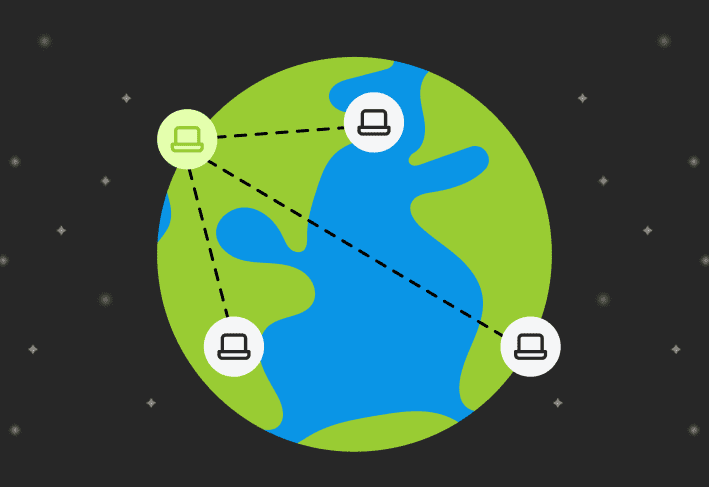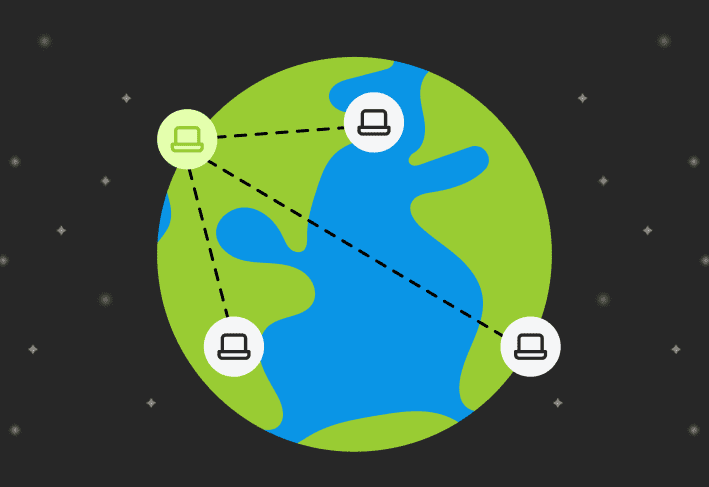IaaS, or infrastructure as a service, is the base-level tier of cloud computing services. When you sign up for IaaS, you can access the cloud and its physical hardware components. From there, you can build your own servers, allocate storage, and manage your software within the cloud.
What is cloud computing?
Cloud computing is the process of accessing the cloud (and the servers, storage, applications, and networking components that make up the cloud) remotely via the internet.
Need a more in-depth refresher? Check out our guide to cloud computing.
How IaaS works
When you sign up for IaaS, you essentially lease physical hardware you connect to via the internet. You gain access to remote equipment and can use it to do many of the same things that physical equipment in your office can do: access storage, host servers, and offer networking resources, for example.
Common use cases for IaaS
IaaS can be a great resource when you have occasional needs in your environment. Here are a few of the most common use cases for IaaS.
Testing and developing
Need a dev or test environment? You can use IaaS to quickly spin these up. Then, your team can use these virtual environments as sandboxes — and destroy them once the project is ready to enter your prod environment.
Performance
Say you’re working on a project and need some extra computing power beyond what your on-site infrastructure offers. Cloud computing can help pick up the slack and augment those processing needs.
IaaS providers offer virtual machines and cloud instances you can provision in a flash. And because cloud computing services operate on a pay-as-you-go basis, you’ll pay only for the performance you use.
Load balancing
Remember that time when your marketing team released an ebook so good that users overwhelmed your website, making it just ... crash? IaaS can help you keep up with these spikes in demand through load balancing.
Many IaaS providers offer load balancing, which helps distribute traffic when volume is abnormally high. It helps to “share the love” so that no single networking resource becomes bogged down with too much traffic. No more 404s when your next 🔥 ebook hits the web.
Storage and backups
IaaS resources can be part of your backup plan in your disaster recovery strategy. IaaS providers offer remote storage via the cloud to store those important assets that minimize downtime during a catastrophic event, such as a ransomware attack.
Access to this extra storage via the cloud helps you avoid overwhelming your environment. Plus, at least one of your backups should be remote and offsite, so using IaaS resources covers this cybersecurity compliance standard.
The difference between IaaS and PaaS
Infrastructure as a service is often compared to platform as a service, or PaaS. While IaaS is the base-level tier of cloud computing services, PaaS is a step above IaaS. PaaS allows you to develop applications without having to build or maintain servers. With IaaS setups, it’s on you to do the provisioning and configuring.
How to implement IaaS
Although every organization is different, you can usually implement IaaS in a few standard(ish) steps.
1. Round up your core team
Identify who on your team can help you adopt IaaS services. We recommend starting with just a few team members to scope out and implement your migration plan. Flying solo? Please accept this imaginary hat tip.
2. Identify your use cases
With your core team, brainstorm which IaaS use cases are relevant to your business. Consider data storage, processing power, networking needs, and other use cases relevant to your organization.
This is also the time to run your plans by executive leadership, as you’ll need their buy-in early in the process to save you a lot of time and headaches later. (You don’t want your CEO asking why you’re six months into a multiyear project they're just now hearing about.)
3. Scope out the requirements
Before comparing IaaS providers, you’ll need to have a good idea of your organization’s requirements. Consider storage, server locations, and other needs specific to your environment. Have this list handy before moving on to the next step.
4. Select an IaaS provider
There are many IaaS providers. A few of the most common IaaS providers include the following:
Microsoft (Microsoft Azure)
Google (Google Cloud)
Amazon (Amazon Web Services)
IBM (IBM Cloud)
VMware
You’ll need to dig in and research these providers to select the one that most closely matches your company’s needs.
5. Migrate
Once you’ve signed up for an IaaS solution, it’s time to migrate. And just to forewarn you, migrating from on-prem resources to the cloud is a huge undertaking that often takes years from start to finish. (Sorry, we know it stinks.)
Work with your core team and IaaS provider to make your migration as easy as possible. There's no sugarcoating it: The process is time consuming and daunting. For example, one important decision to make early on pertains to permissions (ugh).
Our best advice here is to plan thoroughly and plan early. You’ll want to build your migration plans into your overall business plan, working in time to depreciate your existing hardware as you move toward cloud migration.
Types of businesses that use IaaS
The two primary types of businesses that use IaaS are new businesses and small businesses.
New businesses
If you’re looking into IaaS as a new business, you may have just struck gold.
For new businesses, IaaS is often an affordable, convenient solution. You don’t have to have a fully fledged team of networking and security experts to use IaaS. You just need one person who knows provisioning basics — and our guess is that’s you, our sysadmin friend. And because the business is new, you can completely skip the convoluted process of migrating from on-prem to the cloud. You can just start fresh in the cloud. *cue angels singing in the distance*
Small businesses
IaaS might be an affordable and sensible solution if you work at a small business. Like new businesses, small businesses can benefit from adopting an IaaS platform by eliminating the cost of hiring employees to focus on networking and security. Plus, as a small business, you likely have less data to store than an enterprise organization. IaaS is designed to scale up and down, so you only pay for how much (or how little) you use. These cost savings might make IaaS a great solution for small businesses.
It’s worth noting that just because you start out using IaaS doesn’t mean you’re forever bound to it. Your company’s needs may evolve, forcing you to move on-prem or to take a hybrid approach.
David Heinemeier Hansson, Basecamp and HEY cofounder and creator of Ruby on Rails, wrote an interesting piece on how Basecamp and HEY’s needs evolved, forcing the companies to leave the cloud behind.
It’s worth a read if you want a behind-the-scenes look at another person's thought process when it was time to reevaluate the cloud.
Benefits of IaaS
IaaS's benefits include agility, competitive pricing, reliability, and fewer hardware management responsibilities.
Agility
IaaS offers far more agility than traditional on-prem solutions. Need a virtual machine (VM)? You can provision one in minutes. Need additional computing power — but only to get you through that one project your boss needs by end of week? Done! IaaS is far more agile because you can use only what you need and nothing more.
Pricing
And speaking of using only what you need, that’s exactly what you pay for. This helps you scale your operations as needed and pay for services used accordingly.
You might assume that moving to the cloud is more expensive than staying on-prem; however, it really depends on your environment and needs. For example, say you have periods throughout the year when you need more processing power. It’s an occasional, not permanent, need. Using the cloud for a month or two can be far more cost efficient than implementing and maintaining permanent on-prem hardware. On the other hand, if you have a lot of data that you need to store permanently, it may be cheaper to remain on-prem. You just need to validate your organization’s specific needs and decide accordingly.
Reliability
Cloud services are known for their reliability. For example, Amazon Web Services commits to 99.99% availability for each of its Amazon EC2 regions. You can almost guarantee that your IaaS services will always be available whenever you need them (as long as you have a working internet connection).
Fewer hardware management responsibilities
When you partner with an IaaS provider, you pay for the luxury of not worrying about on-prem hardware. Upkeeping, maintaining, and securing this hardware are burdens for your cloud service provider (CSP) to solve. That frees up your time and resources to work on other things.
Disadvantages of IaaS
IaaS comes with a few notable disadvantages, including unexpected costs, reliance on outside resources, confusing terms of service, and a lot of up-front decision-making.
Unexpected costs
IaaS is a pay-as-you-go service, which means you’re billed for every resource you use. It’s not uncommon to get carried away using the resources IaaS provides. Sometimes, this may lead to a surge in the cost of using IaaS services — and a surprise bill that makes your boss feel some unpleasant feelings.
Reliance on outside resources
Although cloud providers are usually very secure, at the end of the day, IaaS providers are third-party resources. This means that if they have a data breach or a hardware failure, you may have a data breach or a hardware failure.
Confusing terms of service
Unfortunately, many IaaS providers have terms of service that are as clear as mud. It can take some time and effort to sort out the terms you’re agreeing to when signing on the dotted line. But good IaaS providers help you understand exactly what services you’re signing up for and their associated costs. Ask as many questions as you need to feel comfortable with signing on the dotted line.
Decision-making
I love a good game where every decision you make leads you down another path. (Baldur’s Gate 3 is currently a staple in the Bishop household — even after the nonsense with Hotfix 4's rollback that temporarily broke all our saves.) But one thing that is not enjoyable is when decision-making leads you down one rabbit hole after another, especially at your job.
There are so many decisions you have to make when moving to the cloud. For example, do you want to move entirely to the cloud, or does a hybrid environment make more sense? Should your permissions remain in Active Directory, or should you move those to the cloud? Who needs permission to access your company’s cloud, anyway? Each of these decisions changes your workflow. And the list of options goes on and on.
Though it might give you a headache, planning ahead and deciding on these options ahead of time saves you some trouble when you’re ready to migrate. But do your best to avoid decision paralysis — none of this is permanent, and you can always evolve or roll back your instance as you need.
And since you’re living life among the clouds, why not streamline your IT tasks? Deploy custom or prebuilt packages and manage your devices right from the cloud with PDQ Connect. Sign up for a free 14-day trial.





